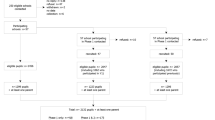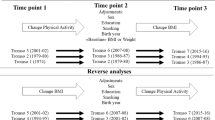Abstract
Objective:
To investigate time trends in overweight and Leisure Time Physical Activities (LTPA) in The Netherlands since 1980. Intra-national differences were examined stratified for sex, age and urbanisation degree.
Subjects and methods:
We used a random sample of about 140 000 respondents aged 20–69 years from the Health Interview Survey (Nethhis) and subsequent Permanent Survey on Living Conditions (POLS). Self-reported data on weight and height and demographic characteristics were gathered through interviews (every year) and data on LTPA were collected by self-administered questionnaires (1990–1997, 2001–2004). Linear regression analysis was performed for trend analyses.
Results:
During 1981–2004, mean body mass index (BMI) increased significantly by 1.0 kg/m2 (average per year=0.05 kg/m2). Trends were similar across sex and different degrees of urbanisation, but varied across age groups. In 20-to 39-year-old women, mean BMI increased by 1.7 kg/m2, which was more than in older age groups (P⩽0.05). With respect to LTPA, no clear trend was observed during 1990–1997 and 2001–2004. The (absence of) trends were similar across sex and urbanisation degrees, but varied across age groups. During 2001–2004, 20-to 39-year-old women spent ≈150 min/week less on LTPA compared to older women, while this difference was smaller during 1990–1997.
Conclusions:
Mean BMI increased more in younger women, which is consistent with the observation that this group spent less time on LTPA during recent years. Although the overall increase in overweight could not be explained by trends in LTPA, the younger women should be considered as a target group for future physical activity interventions. The influence of the ‘obesogenic environment’ seems to be similar across different degrees of urbanisation.
This is a preview of subscription content, access via your institution
Access options
Subscribe to this journal
Receive 12 print issues and online access
$259.00 per year
only $21.58 per issue
Buy this article
- Purchase on Springer Link
- Instant access to full article PDF
Prices may be subject to local taxes which are calculated during checkout




Similar content being viewed by others
References
Flegal KM, Carroll MD, Kuczmarski RJ, Johnson CL . Overweight and obesity in the United States: prevalence and trends, 1960–1994. Int J Obes Relat Metab Disord 1998; 22: 39–47.
Sundquist K, Qvist J, Johansson SE, Sundquist J . Increasing trends of obesity in Sweden between 1996/97 and 2000/01. Int J Obes Relat Metab Disord 2004; 28: 254–261.
Seidell JC, Verschuren WM, Kromhout D . Prevalence and trends of obesity in The Netherlands 1987–1991. Int J Obes Relat Metab Disord 1995; 19: 924–927.
Prentice AM, Jebb SA . Obesity in Britain: gluttony or sloth? BMJ 1995; 311: 437–439.
Field AE, Coakley EH, Must A, Spadano JL, Laird N, Dietz WH et al. Impact of overweight on the risk of developing common chronic diseases during a 10-year period. Arch Intern Med 2001; 161: 1581–1586.
Hill JO, Peters JO . Environmental contribution to the obesity epidemic. Science 1998; 280: 1371–1374.
Livingstone MB, Black AE . Markers of the validity of reported energy intake. J Nutr 2003; 133 (Suppl 3): 895S–920S.
Wendel-Vos GC, Schuit AJ, Saris WH, Kromhout D . Reproducibility and relative validity of the short questionnaire to assess health-enhancing physical activity. J Clin Epidemiol 2003; 56: 1163–1169.
Schmitz KH, Jacobs Jr DR, Leon AS, Schreiner PJ, Sternfeld B . Physical activity and body weight: associations over ten years in the CARDIA study. Coronary Artery Risk Development in Young Adults. Int J Obes Relat Metab Disord 2000; 24: 1475–1487.
Vioque J, Torres A, Quiles J . Time spent watching television, sleep duration and obesity in adults living in Valencia, Spain. Int J Obes Relat Metab Disord 2000; 24: 1683–1688.
Pratt M, Macera CA, Sallis JF, O'Donnell M, Frank LD . Economic interventions to promote physical activity: application of the SLOTH model. Am J Prev Med 2004; 27: 136–145.
Health Council of the Netherlands. Overweight and Obesity (in Dutch). Health Council of the Netherlands: The Hague, 2003. (Report No.: 2003/07).
Egger G, Swinburn B . An ‘ecological’ approach to the obesity pandemic. BMJ 1997; 315: 477–480.
Sturm R . The economics of physical activity: societal trends and rationales for interventions. Am J Prev Med 2004; 27: 126–135.
Reddy KS, Prabhakaran D, Shah P, Shah B . Differences in body mass index and waist: hip ratios in North Indian rural and urban populations. Obes Rev 2002; 3: 197–202.
van der Lucht FVH . Health in the Cities (in Dutch). National Institute for Public Health and the Environment, Bilthoven, RIVM: The Netherlands, 2002. (Report No.: 270555003).
Statistics Netherlands. Netherlands Health Interview Survey 1981–1995. SDU Publishers/CBS-Publications: The Hague, 1996.
Riele S . Vertekening door non-respons: Hoe nauwkeurig zijn de uitkomsten van persoonsenquêtes? Soc Econ Maandstat 2002; 4: 20–25.
Rowland ML . Self-reported weight and height. Am J Clin Nutr 1990; 52: 1125–1133.
Boström G, Diderichsen F . Socioeconomic differentials in misclassification of height, weight and body mass index based on questionnaire data. Int J Epidemiol 1997; 26: 860–866.
Kuskowska-Wolk A, Bergstrom R . Trends in body mass index and prevalence of obesity in Swedish men 1980–1989. J Epidemiol Community Health 1993; 47: 103–108.
Kuskowska-Wolk A, Bergstrom R . Trends in body mass index and prevalence of obesity in Swedish women 1980–1989. J Epidemiol Community Health 1993; 47: 195–199.
Hoffmeister H, Mensink GB, Stolzenberg H . National trends in risk factors for cardiovascular disease in Germany. Prev Med 1994; 23: 197–205.
Lahti-Koski M, Vartiainen E, Männistö S, Pietinen P . Age, education and occupation as determinants of trends in body mass index in Finland from 1982 to 1997. Int J Obes Relat Metab Disord 2000; 24: 1669–1676.
Gutiérrez-Fisac JL, Banegas Banegas JR, Artalejo FR, Regidor E . Increasing prevalence of overweight and obesity among Spanish adults, 1987–1997. Int J Obes Relat Metab Disord 2000; 24: 1677–1682.
Rütten A, Vuillemin A, Ooijendijk WT, Schena F, Sjostrom M, Stahl T et al. Physical activity monitoring in Europe. The European Physical Activity Surveillance System (EUPASS) approach and indicator testing. Public Health Nutr 2003; 6: 377–384.
World Health Organization. The World Health Report 2002: Reducing Risks, Promoting Healthy Life. World Health Organisation: Geneva 2002.
Brownson RC, Smith CA, Pratt M, Mack NE, Jackson-Thompson J, Dean CG et al. Preventing cardiovascular disease through community-based risk reduction: the Bootheel Heart Health Project. Am J Public Health 1996; 86: 206–213.
Luepker RV, Murray DM, Jacobs Jr DR, Mittelmark MB, Bracht N, Carlaw R et al. Community education for cardiovascular disease prevention: risk factor changes in the Minnesota Heart Health Program. Am J Public Health 1994; 84: 1383–1393.
Heliövaara M, Aromaa A . Parity and obesity. J Epidemiol Community Health 1981; 35: 197–199.
Brown JE, Kaye SA, Folsom AR . Parity-related weight change in women. Int J Obes Relat Metab Disord 1992; 16: 627–631.
Tavani A, Negri E, La Vecchia C . Determinants of body mass index: a study from northern Italy. Int J Obes Relat Metab Disord 1994; 18: 497–502.
Williamson DF, Madans J, Pamuk E, Flegal KM, Kendrick JS, Serdula MK . A prospective study of childbearing and 10-year weight gain in US white women 25–45 years of age. Int J Obes Relat Metab Disord 1994; 18: 561–569.
Author information
Authors and Affiliations
Corresponding author
Rights and permissions
About this article
Cite this article
Gast, GC., Frenken, F., van Leest, L. et al. Intra-national variation in trends in overweight and leisure time physical activities in The Netherlands since 1980: stratification according to sex, age and urbanisation degree. Int J Obes 31, 515–520 (2007). https://doi.org/10.1038/sj.ijo.0803429
Received:
Revised:
Accepted:
Published:
Issue Date:
DOI: https://doi.org/10.1038/sj.ijo.0803429
Keywords
This article is cited by
-
Spatial Disparity of Sports Infrastructure Development and Urbanization Determinants in China: Evidence from the Sixth National Sports Venues Census
Applied Spatial Analysis and Policy (2023)
-
The Netherlands Epidemiology of Obesity (NEO) study: study design and data collection
European Journal of Epidemiology (2013)
-
Relationship between the physical environment and different domains of physical activity in European adults: a systematic review
BMC Public Health (2012)
-
Age-specific trends in cardiovascular mortality rates in the Netherlands between 1980 and 2009
European Journal of Epidemiology (2011)
-
Socio-economic differences in the use of dairy fat in Russian and Finnish Karelia, 1994–2004
International Journal of Public Health (2010)



